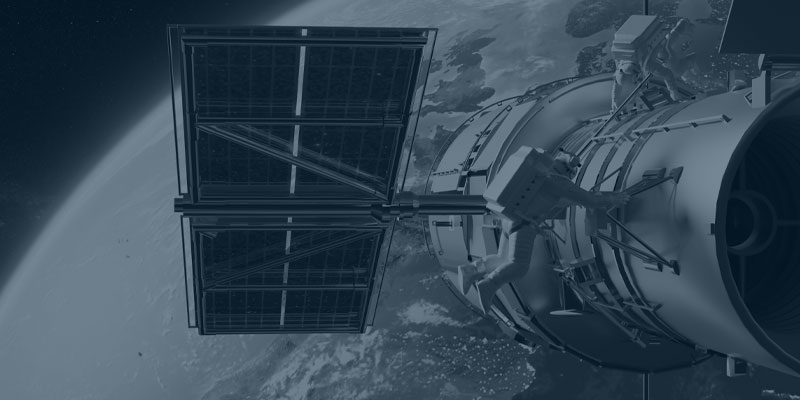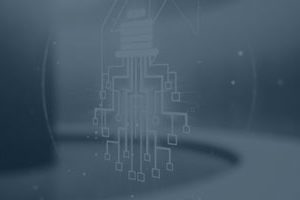Earth observation? It sounds like something that is only performed by governments to follow up on climate change or to spy on other countries. This was indeed the case some time ago, but in the NewSpace era earth observation has become much more accessible. This has unlocked new opportunities for industries ranging from farming to maritime. But how? Where would you start? Well, you’re in the right place to discover. This blog is all about earth observation and the critical role AI plays in this domain.

Trends in NewSpace
What is going on that makes earth observation suddenly so accessible? In NewSpace we see that the satellites have become relatively small. Decreasing the material cost and the cost of bringing them into orbit. This makes it easier for companies to have a presence in space. There has also been a shift from single expensive satellites to constellations of satellites. These consist of duplicates of a satellite that are spread across the globe to increase coverage and reduce costs. Think of a famous billionaire whose space company is doing just that.
In short, companies can now also acquire earth observation data. Aside from using data themselves, they also gain revenue by selling it. This trend of earth observation data being commercially available has truly made earth observation accessible to everyone. By paying a subscription fee, anyone could acquire a monthly quote of data. There even exist platforms where you can get earth observation for free! You are certainly familiar with Google Earth, one such provider of free earth observation data. As you can see, acquiring data has become quite easy. But what makes it so valuable?
What can I do with earth observation data?
The most important thing you can do with this data is to automate the generation of insights. It doesn’t matter if you are a shipping company managing a fleet, an energy company forecasting energy demands, or a farmer wanting a continuous overview of all your crops. You won’t be doing this manually. As the scale of these tasks has become so large, you need to automate this process as much as you can. This is where AI comes in.
As the world gets more globalized, and all our human endeavors scale, automating the generation of insights becomes mandatory in order to not fall behind.
A maritime shipping company might gain insights into how busy certain routes are, how the weather and sea are behaving, or what the ice formations in the arctic look like. A farmer could gain insights into the status of crops. Think not only of the health and readiness to harvest, but the yields as well. To give a few examples you might already have an idea for an application that will generate a lot of value for you. But first of all you will need data, and not just any data, you need the right data. What kind of sensors do you need? You have a lot of options to choose from, from selecting specific spectral bands to LiDAR and other types of sensors. For each of these, you can also determine their characteristics. Then you probably have some requirements for the resolution which can range from a couple of hundred meters per pixel to an incredible thirty centimeters per pixel. Another important requirement is the fly-over time, which determines how long it takes for a satellite to pass by the same location twice. And of course, we cannot forget that there is a cost to all this. Premium EO data can go from a few cents to over 50 euros per square kilometer.
Spring cleaning
Before you can start building applications, you need to do a bit of cleaning to make the data ready for use. Depending on the provider of your data this can be a lot of work or none at all. We distinguish three main steps that typically have to be taken. First is noise removal. Noise sources like stray light, smear and dark offset can automatically be dealt with by using specialized algorithms. Second is pixel labeling, meaning that for each pixel in every picture the location and timestamp need to be determined. Luckily, AI can help you in this early stage as well. There are plenty of algorithms available for this purpose.
The third step can be quite tricky. If you have selected multiple sensors to measure the same phenomena, you need to correct for inter-instrument bias. What do we mean by this? Each of these sensors should be measuring the exact same thing. However, slight differences might occur resulting in different values for the same phenomena. Incorrectly using this raw data could be disastrous for your project. It is of vital importance to correct this bias first! Fortunately, machine learning algorithms can be employed to this bias and correct it, even if we don’t fully understand where the bias is coming from.

Supervised vs. unsupervised model ©VERHAERT
Applications
Spring cleaning is done and the data is now ready to use. It’s time to actually build algorithms that can extract insights from the data. Typically, you would want to use a supervised learning algorithm for this kind of problem. But, that means we need examples to teach the algorithm what it should do. And I don’t just mean a few. A large dataset needs to be gathered and manually labeled in order to be able to build a good algorithm. You want to determine the air quality from spectral imaging? Well, then you need to make a lot of manual measurements first so the algorithm can learn from your examples.
Of course, this kind of approach is very expensive, so don’t we know a better way? Within the world of machine learning there also exists a group of unsupervised learning algorithms. These don’t need examples at all. One of the more interesting approaches to earth observation goes as follows:
-
- You select the sensors which should capture your problem quite well
- You apply a clustering algorithm with a high number of classes on this data. This algorithm can divide the world into similar parts based on this data.
- Finally, it’s up to a domain expert to give meaning to these classes.
Let’s go back to the air quality example. If the right information is contained in the data, the clustering algorithm will divide the world into parts with similar air quality. It is then up to a domain expert to give meaning to these classes in order to make the algorithm usable. Measurements still need to be made, but far less than before. The result is an approach that is much cheaper both in time and resources.
Conclusion
Leveraging AI techniques enables us to automatically generate insights from the vast amount of earth observation data that is at our disposal. In these times of rapid globalization, this is a must as we just can’t keep up performing these tasks manually. If you want to generate insights from the vast amount of earth observation data that is at your disposal. And even if you want to generate these insights manually, you can benefit from AI to clean up your data. No matter how you look at it, AI has become critical in any earth observation project we can imagine. Applying it unlocks a whole new area of opportunities.




